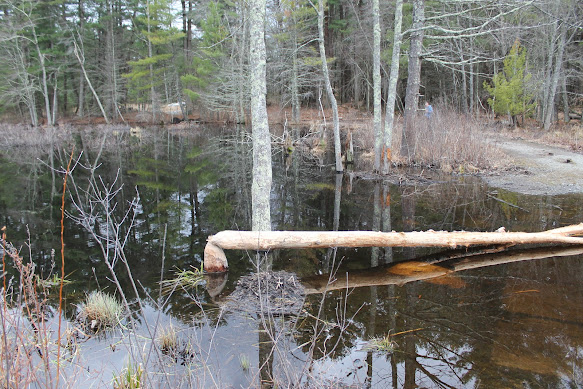WILDLIFE PHOTOGRAPHY AT A BEAVER POND
...So I finally figured out how to use my old Canon Rebel T3. Being able to use a DSLR is huge for me, because now I can get way better images, than what I would get on my phone. I tested it out at Assabet National Wildlife Refuge. Luckily, that day turned out to be great for wildlife photography. I realize that my photos are still not at the quality I want them at. Despite that, and the rain, I got decent images.
As soon as I walked out, onto the path, I realized that it was flooded in some parts. The path stretches across the river like a dam. Bikers were stopping and turning around, because there was no away across without getting your shoes soaked.

There were ripples coming from a patch of vegetation in the water. A duck? a turtle? no. two muskrats were splashing around. I couldn't tell what they were doing. Fighting? Mating? Playing? Cleaning each other? One of them dove under and disappeared by the time my camera was ready.
Once I got photos of that muskrat, I noticed two people looking up with binoculars. I walked past them, Trying to see what they were looking at. I thought they had maybe found the barred owl that kept hooting, echoing around the whole river. I couldn't see anything. I dismissed it and kept walking. I walked out to a little peninsula, which took me to the end of a beaver dam that stretched across the river. Another muskrat was only about 30 feet in front of me. I guess they were taking advantage of the warm weather. It began to rain shortly after, and the muskrat dove under the water, resurfacing further away. It was headed for the beaver lodge. I dont know if it was the weather that made it leave, or me...

Beavers sometimes let their muskrat neighbors share there lodges during colder months: The more body heat is trapped in the lodge, the energy less each individual has to spend shivering. Apparently, the muskrats also "pay rent" by leaving any leftover food inside, so the starving beavers can benefit more from their stay. Muskrats do not usually live in beaver dens, though. They typically dig dens into riverbanks, or just build a hidden nest in the middle of the cattails and reeds.
Above the island was a great blue heron rookery (group of nests). Three big tangles of sticks and reeds, built high in some dead pines. These trees grew here a long time ago, but could not survive the flooding caused by the dams (both artificial and beaver-made). The remaining stands of trees provide nesting space safe from raccoons, fishers, and humans. It also allows them to fish without going far from their chicks...
The rain fell heavier and heavier. I worked my way into the shelter of the woods, but I still had time before I was going to be picked up. I decided to return to the main path and work my way down the riverbank. Before long, I found a muskrat. Possibly the same one that I photographed at the beginning. It repeatedly dove underwater, surfacing at a new place every time. It seemed very comfortable with me getting close. I was crouched behind the unearthed roots of a fallen tree, and the wet little rodent was less than 10 feet from me, cleaning itself, and relaxing.
I then walked back to the car to go home and realized just how much better a DSLR is than a smartphone's camera. I'll probably return with the camera to the pond this weekend or over April vacation, now that I have a little experience with it. By then, even more animals will have emerged.












.jpeg)

Comments
Post a Comment